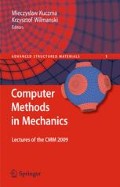Abstract
Tissue-implant interactions were analysed by investigations of bone adaptation processes, especially in the region surrounding the implant. In such cases all factors stimulating bone negative remodelling should be taken in consideration. Because of that, a three-step analysis of implant alignment to the surrounding tissues was carried out. Basic parameters of the bone-implant interaction were estimated (on the macro level: stiffness characteristics, shear strains distribution, and bone tissue density distribution; on the micro level: trabecular structures development, trabecular microcracks distribution, and bone cells strain distribution). Estimation of each parameter was carried out by development of numerical tools which enabled control of bone tissue changes caused by changes in the implant design. All steps of the analysis were carried out using FE models and own simulation procedures.
Access this chapter
Tax calculation will be finalised at checkout
Purchases are for personal use only
Preview
Unable to display preview. Download preview PDF.
References
An, Y.H., Draughn, R.A.: Biomechanical testing of bone and the bone – implant interface. CRC Press, New York (2000)
Beaupre, G.S., Orr, T.E., Carter, D.R.: An approach for time-dependent bone remodeling and remodeling applications: a preliminary simulation. Journal of Orthop. Res. 8, 662–670 (1990)
Burr, D.B., Robling, A.G., Turner, C.H.: Effects of Biomechanical Stress on Bones in Animals. Bone 30, 781–786 (2002)
Bedzinski, R.: Biomechanical engineering - selected topics. Oficyna Wydawnicza Politechniki Wroclawskiej, Wroclaw (1997) (in Polish)
Bedzinski, R., Ostrowska, A., Scigala, K.: Investigations of mechanical structure of long bone. Machine Dynamics Problems 28, 45–50 (2004)
Bedzinski, R., Scigala, K.: FEM analysis of strain distribution in tibia bone and relationship between strains and adaptation of bone tissue. Computer Assisted Mechanics and Engineering Sciences 10, 353–368 (2003)
Bedzinski, R., Scigala, K.: Problems of bone – orthopedic implant interactions. Biomechanica Hungarica 1, 47–56 (2008)
Carter, D.: Skeletal function and form. Cambridge University Press, Cambridge (2001)
Cowin, S.C.: Bone mechanics handbook, 2nd edn. CRC Press, New York (2001)
Currey, J.D.: The effect of porosity and mineral content on the Young’s modulus of elasticity of compact bone. Journal of Biomechanics 21, 131–139 (1998)
Frost, H.M.: A determinant of bone architecture. The minimum effective strain. Clinical Orthopedic 175, 286–292 (1983)
Frost, H.M.: Bone mass and the mechanostat: a proposal. Anat. Rec. 219, 1–9 (1987)
Huiskes, R.: If bone is the answer, then what is the question? J. Anat. 197, 145–156 (2000)
Huiskes, R., Mullender, M.G.: Osteocytes and Bone Lining Cells: Which are the Best Candidates for Mechano-Sensors in Cancellous Bone? Bone 20, 527–532 (1997)
Hurwitz, D.E., Sumner, D.R., Andriacchi, T., Sugar, D.A.: Dynamic knee loads during gait predict tibial bone distribution. Journal of Biomechanics 27, 423–430 (1998)
Knets, I., et al.: Bond strength of implant to the bone tissue and the stress - strain state of bone. Acta of Bioengineering and Biomechanics 8 (2006)
Maquet, P.G.J.: Biomechanics of the knee, 2nd edn. Springer, New York (1977)
Martin, R.B., Burr, D.B.: Structure, Function and Adaptation of Compact Bone. Raven Press, New York (1989)
Piekarski, K.R.: Biomechanics of bone. In: Morecki, A., Fidelus, K., Kedzior, K., Witt, A. (eds.) VII-A International Series of Biomechanics, Warszawa – Baltimore (1981)
Pozowski, A., Bedzinski, R., Scigala, K.: Stress distribution in varus knee after operative correction of its mechanical axis. Acta of Bioengineering and Biomechanics 3, 31–40 (2001)
Rho, J.Y., Kuhun-Spearing, L., Zioupos, P.: Mechanical properties and hierarchical structure of bone. Med. Eng. Phys. 20, 92–104 (1998)
Taylor, M., Tanner, K.E., Freeman, M.A.R.: Finite element analysis of the implanted proximal tibia: a relationship between the initial cancellous bone stresses and implant migration. Journal of Biomechanics 31, 303–310 (1998)
Tsubota, K., Adachi, T., Tomita, Y.: Functional adaptation of cancellous bone in human proximal femur predicted by trabecular surface remodeling simulation toward uniform stress state. Journal of Biomechanics 35, 1541–1551 (2002)
Tsubota, K.: Spatial and temporal regulation of cancellous bone structure. Medical Engineering & Physics 27, 305–311 (2005)
Weinans, H., Huiskes, R., Grootenboer, H.J.: The Behavior of Adaptive Bone-Remodeling Simulation Models. Journal of Biomechanics 25, 1425–1441 (1992)
Zioupos, P.: The accumulation of fatigue microdamage in human cortical bone. Clinical Biomechanics 11, 365–375 (1996)
Author information
Authors and Affiliations
Editor information
Editors and Affiliations
Rights and permissions
Copyright information
© 2010 Springer Berlin Heidelberg
About this chapter
Cite this chapter
Bedzinski, R., Scigala, K. (2010). Biomechanical Basis of Tissue–Implant Interactions. In: Kuczma, M., Wilmanski, K. (eds) Computer Methods in Mechanics. Advanced Structured Materials, vol 1. Springer, Berlin, Heidelberg. https://doi.org/10.1007/978-3-642-05241-5_20
Download citation
DOI: https://doi.org/10.1007/978-3-642-05241-5_20
Publisher Name: Springer, Berlin, Heidelberg
Print ISBN: 978-3-642-05240-8
Online ISBN: 978-3-642-05241-5
eBook Packages: Chemistry and Materials ScienceChemistry and Material Science (R0)

